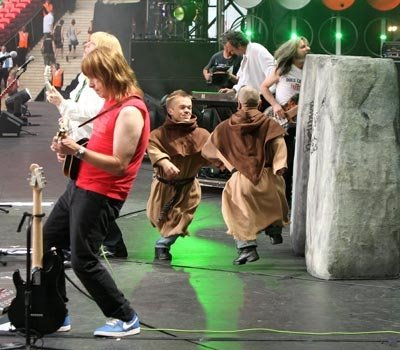 photos by Robert Asplet, blogged from Flickr
photos by Robert Asplet, blogged from Flickr
“A wee bit o’ Scotland has come to the outskirts of Cowboys Stadium, and with it a foggy auld controversy over whether a Scottish sculpture park is also a pagan shrine that might hex the Dallas Cowboys.” “ ‘I believe there’s a devil and that we tugged on his cape.’ ” (From this article, the second a quote from Michael Tummillo.)
Ah, Texas. Welcome to Caelum Moor. Five modern megalithic sculptures made of granite, three of them trilithons, that have been in storage since 1997 have recently been re-erected in a park near Arlington, to the great joy of many art lovers and to the alarm and even anger of some on-the-fringe Christians, led by nursing home chaplain Michael Tummillo, who assert that it is pagan, therefore evil and therefore likely to attract–yes–the devil!
 It is clear that Tummillo has more belief in the power of the sculptures than anyone else does and maybe he ought to be admired for that. Pagans, at least the ones I know, would be unlikely to expect that modern sculptures recently placed near two sports stadiums will draw in any kind of spirits, let alone a spirit who is, let’s face it, pretty much a Christian construct.
It is clear that Tummillo has more belief in the power of the sculptures than anyone else does and maybe he ought to be admired for that. Pagans, at least the ones I know, would be unlikely to expect that modern sculptures recently placed near two sports stadiums will draw in any kind of spirits, let alone a spirit who is, let’s face it, pretty much a Christian construct.
You know the drill–Tummillo and his gang somehow get from worrying about pagans and Wiccans worshiping at the sculpture park to talking about satanism, which is much closer to being a heretical sect of Christianity than it is to having anything to do with Wicca or paganism. And it all makes assumptions that don’t work, like that these sculptures are not art but religious objects, or that people won’t practice paganism or Wicca if the sculptures aren’t there.
Of course, the vast majority of Christians can enjoy these sculptures for their beauty and the resonance of ancient Britain they carry, without getting weird about it. They can instead chuckle at the bit about Scotland in that opening line above. Name a stone circle with lintels in Scotland–We didn’t think so!
 Controversy aside, the combination of landscape and sculpture in this park seems to transcend its site in the sports and business complex. You can see a walkthrough of Caelum Moor here. There is no circle, none of the other characteristics of Stonehenge, but it does have a grand feel, even over the internet. We give it 6½ druids. They’re not real druids, okay? We don’t want to scare anyone!
Controversy aside, the combination of landscape and sculpture in this park seems to transcend its site in the sports and business complex. You can see a walkthrough of Caelum Moor here. There is no circle, none of the other characteristics of Stonehenge, but it does have a grand feel, even over the internet. We give it 6½ druids. They’re not real druids, okay? We don’t want to scare anyone!
The artist’s name is Norman Hines. We applaud his beautiful work! And a note about Michael Tummillo: he has written a book about his experience fighting Caelum Moor the first time it was up (so we doubt he’s trying to drum up media coverage! 😉). And as for the Cowboys–their problems probably can’t be traced back to public sculpture. Just a hunch.
Our thanks to Karen Hetherington for telling us about this one. And again, we wish everyone a wonderful Halloween and Samhain!
[See the comments for a statement from M. Tummillo.]




 photo by Peter Renn, from the BBC
photo by Peter Renn, from the BBC At a Glastonbury concert in June they had a rather smaller one, but it appears to have been closer to 4 feet than 18 inches high.
At a Glastonbury concert in June they had a rather smaller one, but it appears to have been closer to 4 feet than 18 inches high. photo by Thelma June Jackson, with permission
photo by Thelma June Jackson, with permission
 As you can see on the left, diagrams and explanations of Stonehenge, and possibly of fossil crinoid stems, accompanied the models. Was this a science fair project or some other kind of display? We can only speculate, but we’re glad it was there to add to the weird materials list for Stonehenge replicas!
As you can see on the left, diagrams and explanations of Stonehenge, and possibly of fossil crinoid stems, accompanied the models. Was this a science fair project or some other kind of display? We can only speculate, but we’re glad it was there to add to the weird materials list for Stonehenge replicas!




 Now we know that these topics rub many of our readers the wrong way, but they are, as inevitably as archaeology, engineering and astronomy, tied up in people’s perception of Stonehenge. And when the henge parasite hatches in the mind, it goes straight as if by instinct for the most vulnerable area. Sometimes it’s art, sometimes it’s science, sometimes it’s tourism, sometimes it’s bravado, sometimes it’s nostalgia, sometimes it’s play and sometimes it’s a mystical inclination. That last is the case here.
Now we know that these topics rub many of our readers the wrong way, but they are, as inevitably as archaeology, engineering and astronomy, tied up in people’s perception of Stonehenge. And when the henge parasite hatches in the mind, it goes straight as if by instinct for the most vulnerable area. Sometimes it’s art, sometimes it’s science, sometimes it’s tourism, sometimes it’s bravado, sometimes it’s nostalgia, sometimes it’s play and sometimes it’s a mystical inclination. That last is the case here. So scoff if you must, scoffers, but in the henging world there are many mansions and all who henge are welcome. You can read more by and about Thomas and his henging inspiration
So scoff if you must, scoffers, but in the henging world there are many mansions and all who henge are welcome. You can read more by and about Thomas and his henging inspiration